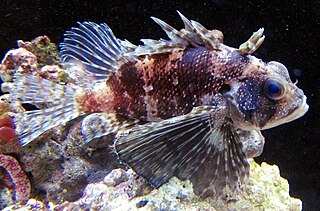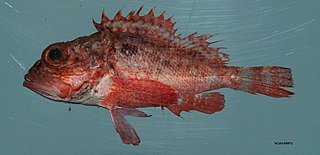
Dendrochirus biocellatus, the twospot turkeyfish, twinspot lionfish, twoeyed lionfish or ocellated lionfish, is a species of marine ray-finned fish belonging to the family Scorpaenidae, the scorpionfishes and lionfishes. This species is widespread throughout the tropical waters of the Indo-West Pacific region, In the wild, the species eats small fish as well as shrimp.

The clearfin lionfish, also called the tailbar lionfish, radiata lionfish, fireworks fish or radial firefish, is a carnivorous, ray-finned fish with venomous spines belonging to the family Scorpaenidae, the scorpionfishes and lionfishes. This species lives in the Indian and western Pacific Oceans. This is the only lionfish species which has spines without any markings. It can also be recognized by the pair of horizontal white stripes on its caudal peduncle.

Dendrochirus is a genus of marine ray-finned fishes belonging to the family Scorpaenidae, the scorpionfishes. They are mostly known as turkeyfishes or pygmy lionfishes. They are native to the Indian and Pacific Oceans. They are also popular aquarium fish.

Pteroidichthys is a genus of marine ray-finned fish belonging to the family Scorpaenidae, the scorpionfishes. The scorpionfishes in this genus are distributed in the Indian and Pacific Oceans.

Pterois miles, the devil firefish or common lionfish, is a species of ray-finned fish native to the western Indo-Pacific region. It is frequently confused with its close relative, the red lionfish. The scientific name is from Greek pteron, meaning "wing", and Latin miles, meaning "soldier".

Pterois antennata, the spotfin lionfish, banded lionfish, broadbarred lionfish, broadbarred firefish, raggedfinned firefish, raggedfinned scorpionfish or roughscaled lionfish, is a species of marine ray-finned fish belonging to the family Scorpaenidae, the scorpionfishes and lionfishes. It is found in the tropical Indian and Western Pacific Oceans.

Pterois mombasae, the African lionfish, deepwater firefish or frillfin turkeyfish, is a species of marine ray-finned fish belonging to the family Scorpaenidae, the scorpionfishes and lionfishes. It is found in the tropical Indian Ocean, typically in soft-bottomed areas of the ocean, often in conjunction with invertebrate growth. It grows to a maximum size of 20 cm, and is of moderate commercial value.

Dendrochirus brachypterus, the dwarf lionfish, short-finned turkeyfish, shortspine rockcod or shortspine scorpionfish, is a species of marine ray-finned fish belonging to the family Scorpaenidae, the scorpionfishes and lionfishes. It is found in the Indo-Pacific. It is sometimes found in the aquarium trade.

Dendrochirus barberi, the Hawaiian lionfish or green lionfish, is a species of marine ray-finned fish belonging to the family Scorpaenidae, the scorpionfishes and lionfishes. It occurs in the Eastern Central Pacific. It occasionally makes its way into the aquarium trade.

Scorpaenopsis papuensis, the Papuan scorpionfish, is a species of venomous marine ray-finned fish belonging to the family Scorpaenidae, the scorpionfishes. It is found in the Indo-West Pacific.
The Andover lionfish is a species of marine ray-finned fish belonging to the family Scorpaenidae, the scorpionfishes and lionfishes. It is found in the western Pacific Ocean.
Scorpaenodes minor, the minor scorpionfish or Brock's scorpionfish, is a species of venomous marine ray-finned fish belonging to the family Scorpaenidae, the scorpionfishes. This species is found in the Indian and Pacific Oceans.

Pterois russelii, the largetail turkeyfish, plaintail firefish, plaintail turkeyfish, Russell's firefish, Russell's lionfish, spotless butterfly-cod or the spotless firefish, is a species of ray-finned fish with venomous spines belonging to the family Scorpaenidae, the scorpionfishes and lionfishes. It is native to the Indo-Pacific Ocean from the eastern part of Africa to the Persian Gulf.
Pterois brevipectoralis is a species of marine ray-finned fish belonging to the family Scorpaenidae, the scorpionfishes and lionfishes. This species is found in the Western Indian Ocean at a depth of 70 to 80 m.

Scorpaenopsis diabolus, the false stonefish, false scorpionfish or the devil scorpionfish, is a species of venomous marine ray-finned fish belonging to the family Scorpaenidae, the scorpionfishes. It has venomous spines and lives in the tropical Indian and Pacific Oceans as well as in the Red Sea. It is a bottom-dwelling predator that relies on its camouflage to catch passing prey.

The Luna lionfish, the dragon's beard fish or Japanese lionfish, is a species of marine ray-finned fish belonging to the family Scorpaenidae, the scorpionfishes and lionfishes. It is found in the western Pacific Ocean.

Scorpaena brasiliensis, the barbfish, goosehead, scorpionfish, orange scorpionfish and red barbfish, is a species of marine ray-finned fish belonging to the family Scorpaenidae, the scorpionfishes. It is found in the Western Atlantic Ocean. This species has venom on its fin spines.

Scorpaenodes guamensis, the Guam scorpionfish or common scorpionfish, is a species of venomous, marine, ray-finned fish belonging to the family Scorpaenidae, the scorpionfishes. It has a wide Indo-Pacific distribution.

Pterois cincta, the Red Sea lionfish or Red Sea clearfin lionfish, is a species of marine ray-finned fish belonging to the family Scorpaenidae, the scorpionfishes and lionfishes. It is found in the Red Sea.
Pterois paucispinula is a species of marine ray-finned fish belonging to the family Scorpaenidae, the scorpionfishes and lionfishes. It is found in the Western Pacific Ocean.

















